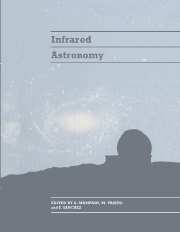Book contents
- Frontmatter
- Contents
- List of Participants
- Preface
- 1 Star Formation
- 2 Last Stages of Stellar Evolution
- 3 The Milky Way Galaxy and the Galactic Centre
- 4 Galaxies in the Infrared
- 5 Cosmology
- 6 G25.2+0.2, a New Ring Nebula Around a Luminous Blue Star: Case Study for the Importance of IR Observations
- 7 Two Colloquia on Cosmic Dust
- 8 Infrared Instrumentation
- 9 Infrared Astronomy with Satellites
6 - G25.2+0.2, a New Ring Nebula Around a Luminous Blue Star: Case Study for the Importance of IR Observations
Published online by Cambridge University Press: 23 December 2009
- Frontmatter
- Contents
- List of Participants
- Preface
- 1 Star Formation
- 2 Last Stages of Stellar Evolution
- 3 The Milky Way Galaxy and the Galactic Centre
- 4 Galaxies in the Infrared
- 5 Cosmology
- 6 G25.2+0.2, a New Ring Nebula Around a Luminous Blue Star: Case Study for the Importance of IR Observations
- 7 Two Colloquia on Cosmic Dust
- 8 Infrared Instrumentation
- 9 Infrared Astronomy with Satellites
Summary
ABSTRACT
We present infrared images and infrared spectroscopy of the suspected very young supernova remnant G25.5+0.2 first detected at radio wavelengths. The 2.2 μm image exhibits a similar nebular structure to that seen in the radio. Spectroscopic measurements at 2.17 μm show a Brackett gamma line that has the line-to-continuum ratio expected from ionized hydrogen at a temperature near 10,000 K. At 50 km/s resolution, the line is resolved with a FWHM of 200 km/s. Ten micron photometry clearly establishes a connection between G25.5+0.2 and the IRAS source 18344–0632. Most important, the infrared image reveals a point source in the center of the nebula that has properties of a blue luminous star that could excite an ionized ring nebula with the observed radio properties. The supernova hypothesis is ruled out and G25.5+0.2 is almost certainly a ring nebula around a mass losing luminous blue star ˜13 kpc distant and reddened by 20 magnitudes of visual extinction.
INTRODUCTION
Cowan et al. (1989) reported extensive observations of the galactic radio source G25.5+0.2. These included radio continuum images at four frequencies, 21 cm absorption measurements, and a search for radio recombination line emission. Based primarily on the absence of the H76α recombination line, Cowan et al. concluded that G25.5+0.2 is a very young galactic supernova remnant, perhaps only 25 years old. Based on 21 cm HI absorption lines, Cowan et al. give a minimum distance to G25.5+0.2 of 7.2 kpc. White and Becker (1990) and Green (1990) suggest that identification of G25.5+0.2 as a planetary nebula is more likely, based on the radio observations and IRAS fluxes.
- Type
- Chapter
- Information
- Infrared Astronomy , pp. 259 - 274Publisher: Cambridge University PressPrint publication year: 1994

